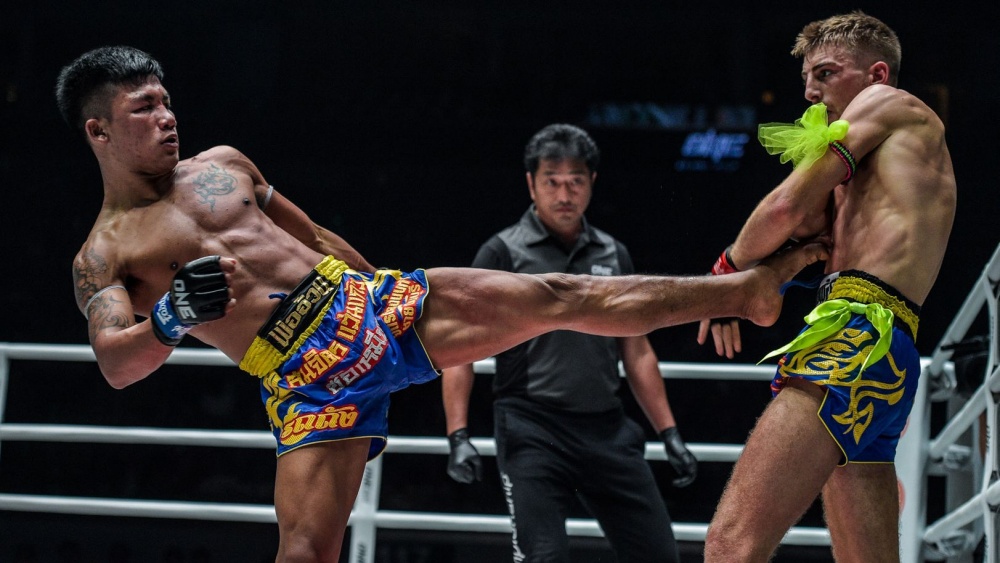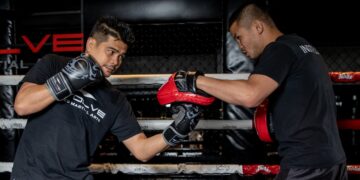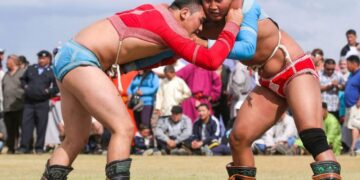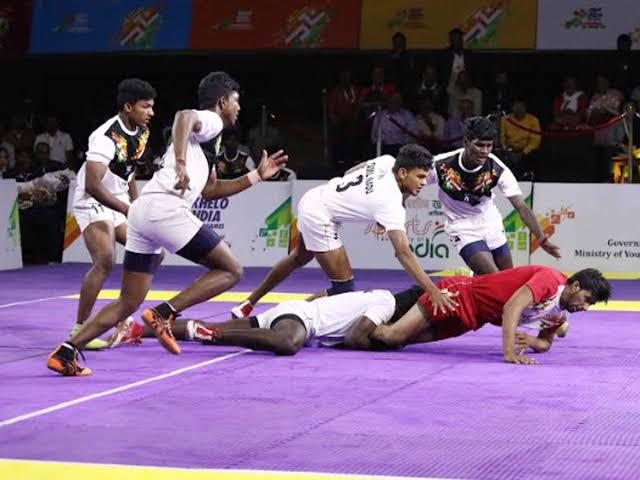
The teep is one of Muay Thai’s fundamental techniques and arguably the most used strike. It’s the kicking version of the jab and serves similar purposes. Also called a push kick, the teep can be used to measure range, control distances, and set up other techniques.
This article will take a detailed look at the mechanics of the teep so you can use it effectively whenever you step inside a ring.
Understanding The Teep
While the teep is also known as the push kick, it’s more than just a simple shove with your leg. It’s a powerful weapon that can demoralize opponents, create space when you’re getting crowded, and disrupt your opponent’s rhythm. A well-timed teep is also more than enough to send an opponent flying to the canvas.
Unlike most kicks used in Muay Thai that involve striking targets with your shin while throwing your leg like a bat, the push kick uses a snapping motion and aims to make contact with your feet.
The teep is an easy technique to learn, and it’s one of the first moves you should master. Watch a professional Muay Thai fight and you’ll quickly see how effective the technique is. If you ever find yourself in a fight and aren’t sure what to do, throw a teep. It’s one of the selected martial arts techniques with both defensive and offensive uses. The technique often leads to the most rewards when paired up against other strikes.
Breaking Down The Teep
Let’s take a closer look at how executing a teep works:
- Stance: Start in your fighting stance with your feet shoulder-width apart. Keep your weight evenly distributed and tighten your core. A balanced stance is crucial when performing the technique since it momentarily leaves you on one leg.
- Chambering The Kick: Raise your kicking leg upward as you prepare to throw the kick by pushing off the balls of your feet. Your knee should be bent at about a 90-degree angle. Chambering the kick instead of simply extending your leg leads to a more powerful attack.
- Snap: Finish the kick by pushing your leg forward with your quads while thrusting your hips forward. This dual action creates a snap that leads to a powerful blow that could force an opponent to take a few involuntary backward steps. Pivot your base foot slightly to add a little more force into the technique. The arm on your opposite side should be up, protecting your face, while the arm on the same side as your kicking leg swings down.
- Recovery: Aim to push through your opponent when throwing a teep and quickly return your leg to your fighting stance.
The teep can be thrown with either leg, and the mechanics remain the same for the most part. Teeps thrown with your lead leg are faster but less powerful, while the reverse is true for teeps thrown with your rear leg. Lead leg teeps are excellent for measuring range, while rear leg teeps are more effective at keeping opponents off you.
Why The Teep Works
Some of the reasons why the teep is one of the most used techniques at all levels of Muay Thai training include:
- Distance Control: The teep allows you to push opponents away whenever necessary. Every successful use forces your opponent to adjust to close the distance, opening up opportunities to land counters.
- Defensive Shield: The teep also serves as a defensive weapon that prevents opponents from launching attacks on you. It can stop opponents right in the middle of combinations, or disrupt their rhythm, hindering their ability to put strikes together.
- Setting Up Combinations: You can use the teep to create openings for follow-up strikes since it leaves opponents off-balanced. You can follow up a teep with punches, kicks, or knees. For example, a teep to the body could force an opponent to lower their guard, leaving them vulnerable to head strikes. You can also feint throwing a teep to create openings.
Drills To Perfect Your Teep
Mastering the teep isn’t something that happens overnight. You must drill it so often that it becomes part of your muscle memory. It takes practice, focus, and plenty of drilling—here are some drills to add to your training regimen:
- Shadow Teep Drills: The first step to mastering the teep is drilling its mechanics more times than you can count. Start slow, ensuring you chamber the kick, thrust your hips forward when extending your leg, and quickly bring your leg back to your stance.
- Heavy Bag Drills: Once you’re comfortable with the technique, it’s time to start aiming at a physical target. A heavy bag gives you excellent feedback on how much power you’re landing with and helps to improve your timing and accuracy. Try to hit the bag as it swings back toward you.
- Partner Drills: Partner drills will improve your ability to land the teep during fights. Have a training partner come at you while you try to keep them off by throwing teeps. This drill helps to improve your ability to gauge distances. You should also work on following up your teeps with combinations.
Some of the common mistakes to avoid when drilling the teep include:
- Overcommitting: Overextending when throwing a teep leaves you off-balance and vulnerable to counterattacks.
- Poor Balance: Not having a balanced stance when throwing the teep also opens you up to counters. Work on your foot placement if you often feel wobbly in your fighting stance.
- Lack Of Follow-Through: Returning your leg to your stance is just as vital as throwing the teep properly. Taking your time to bring your leg back opens you up to counters and getting your leg caught.
- Telegraphing Your Intent: The best teeps are often thrown without any tells. Practice good mechanics to avoid giving opponents any telltale signs they can pick up on.
Dominating With The Teep
The teep is one of the most versatile techniques used in combat sports like Muay Thai, Kickboxing, and MMA. Whether you’re creating distance, opening up your opponent, or disrupting their rhythm, it’s a powerful weapon you can exploit throughout a match
You may also like:
The Art Of The Switch Kick: How To Generate Maximum Power And Speed
The switch kick is a fundamental kicking technique used in Muay Thai that has spread to other combat sports like mixed martial arts and kickboxing. It’s a crafty way to turn your lead leg (weaker…
Becoming a great fighter in martial arts requires more than strength, speed, or endurance—you must also be smart. While most martial artists typically aren’t viewed as the most cerebral members of society, there are clear…
There are a multitude of benefits that can be reaped from training Muay Thai. It can help you lose weight, build confidence, and immerse you in a vibrant lifestyle, rich in a culture that is…
The Muay Thai clinch is one of the most used techniques in striking and can also be used in grappling scenarios like Brazilian Jiu-Jitsu. Like the collar tie in grappling, the Muay Thai clinch can…
Low kicks play an interesting role in Muay Thai. They are powerful, effective, and landing several of them in a round can chip away at both a fighter’s speed and confidence. However, they rarely have…
Muay Thai is undergoing an unprecedented period of growth. In the early 1990’s it was a martial art, relatively unknown outside of Thailand and very few people could have predicted the enormous impact it would…
Mental fatigue is more than just feeling tired. It results from prolonged focus, decision-making, or stress, leading to a noticeable decline in cognitive performance. In today’s fast-paced world, where we juggle multiple tasks, mental exhaustion…
In Brazilian Jiu-Jitsu, the ability to control an opponent and dictate the pace of a match is just as important as finishing a submission. Many practitioners focus heavily on submissions, but without solid positional control,…
The lead hook can be a double-edged sword. Land perfectly, and your opponent’s night might be over. Throw it half-heartedly and you might fight yourself eating a hard right that puts you to sleep. The…
Many strikers don’t think they need to learn how to wrestle until they feel what it’s like to battle a strong grappler. Striking and grappling are the two opposite ends of martial arts training, and…
Feeling spent after an intense martial arts training session is something all fighters relate to. Rubbery legs, aching shoulders, and sore arms are often signs you’ve put in lots of hard work in the gym….
Singapore is known for its diverse and delicious food options, but eating out can get expensive. As inflation news hits the headlines regularly, you might wonder whether you can still find an affordable dining place…
































